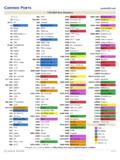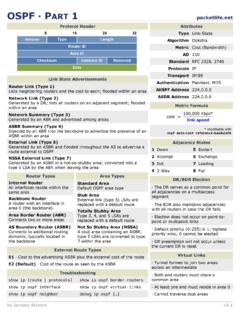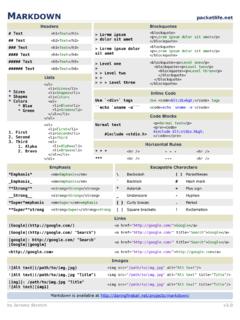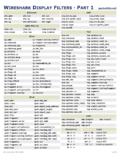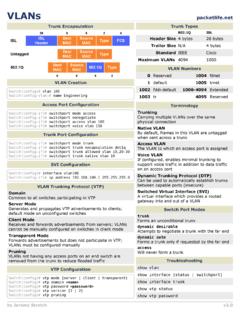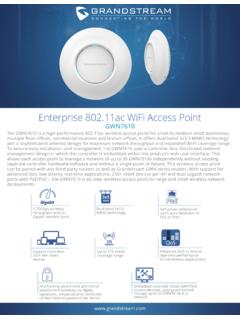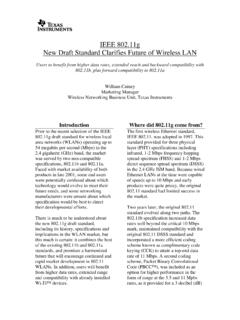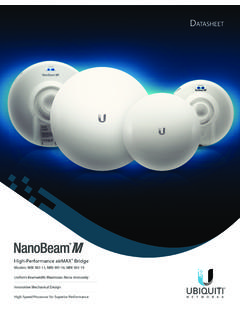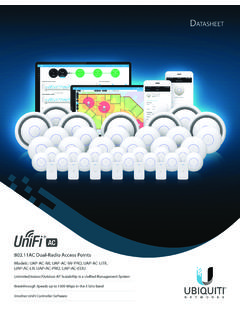Transcription of IEEE 802.11 WLAN · P ART 1 - PacketLife.net
1 Jeremy WLAN PART1 ieee GHzFrequencyWLAN TypesAd HocA WLAN between isolated stations with no central point of control; an IBSSI nfrastructureA WLAN attached to a wired network via an access point; a BSS or ESS54 MbpsMaximum Throughput1999 Ratified21/19 Channels (FCC/ETSI) GHz11 Mbps199911 GHz54 Mbps200311 GHz300 Mbps200932/32 WLAN ComponentsBasic Service Area (BSA)The physical area covered by the wireless signal of a BSSB asic Service Set (BSS)A set of stations and/or access points which can directly communicate via a wireless mediumDistribution System (DS)The wired infrastructure connecting multiple BSSs to form an ESSE xtended Service Set (ESS)A set of multiple BSSs connected by a DS which appear to wireless stations as a single BSSI ndependent BSS (IBSS)An isolated BSS with no connection to a DS.
2 An ad hocWLANM easuring RF Signal StrengthDecibel (dB)An expression of signal strength as compared to a reference signal; calculated as 10log10(signal/reference)dBm Signal strength compared to a 1 milliwatt signaldBw Signal strength compared to a 1 watt signaldBi Compares forward antenna gain to that of an isotropic antennaTerminologyFrame TypesTypeAuthenticationAssociationClassM anagementManagementBeaconProbeManagement ManagementClear to Send (CTS)Request to Send (RTS)ControlControlDataAcknowledgment (ACK)DataControlClient AssociationProbe RequestProbe ResponseAuthentication RequestAuthentication ResponseAssociation RequestAssociation Mbps2 Mbps1 Mbps12/18 Mbps6/9 Mbps64-QAM16-QAM48/54 Mbps24/36 MbpsBasic Service Set Identifier (BSSID)A MAC address which serves to uniquely identify a BSSS ervice Set Identifier (SSID)
3 A human-friendly text string which identifies a BSS; 1-32 charactersCarrier Sense Multiple Access/Collision Avoidance (CSMA/CA)The mechanism which facilitates efficient communication across a shared wireless medium (provided by DCF or PCF)Effective Isotropic Radiated Power (EIRP)Net signal strength (transmitter power + antenna gain - cable loss) Jeremy WLAN PART2 Distributed Coordination Function (DCF)Interframe SpacingShort IFS (SIFS)Used to provide minimal spacing delay between control frames or data fragmentsDCF IFS (DIFS)Normal spacing enforced under DCF for management and non-fragment data framesArbitrated IFS (AIFS)Variable spacing calculated to accommodate differing qualities of service (QoS)Extended IFS (EIFS)
4 Extended delay imposed after errors are detected in a received frameEncryption SchemesWired Equivalent Privacy (WEP)Flawed RC4 implementation using a 40- or 104-bit pre-shared encryption key (deprecated)Wi-Fi Protected Access (WPA)Implements the improved RC4-based encryption Temporal Key Integrity Protocol (TKIP) which can operate on WEP-capable hardwareIEEE (WPA2) ieee standard developed to replace WPA; requires a new generation of hardware to implement significantly stronger AES-based CCMP encryptionClient AuthenticationOpen No authentication is usedPre-shared Encryption KeysKeys are manually distributed among clients and APsLightweight EAP (LEAP)Cisco-proprietary EAP method introduced to provide dynamic keying for WEP (deprecated)EAP-TLSE mploys Transport Layer Security (TLS).
5 PKI certificates are required on the AP and clientsEAP-TTLSC lients authenticate the AP via PKI, then form a secure tunnel inside which the client authentication takes place (clients do not need PKI certificates)Protected EAP (PEAP)A proposal by Cisco, Microsoft, and RSA which employs a secure tunnel for client authentication like EAP-TTLSEAP-FASTD eveloped by Cisco to replace LEAP; establishes a secure tunnel using a Protected Access Credential (PAC) in the absence of PKI certificatesQuality of Service Signal InterferenceReflectionScatteringAbsorpti onRefractionDiffractionAntenna TypesDirectional Radiates power in one focused directionOmnidirectionalRadiates power uniformly across a Multimedia (WMM)A Wi-Fi Alliance certification for QoS; a subset of QoSIEEE ieee WLAN QoS standard ratified in 2005; replaces WMMIEEE markings in the header on wired EthernetIsotropicA theoretical antenna referenced when measuring effective radiated powerDIFSDIFSDIFSDIFSABCDF rameDeferral PeriodRandom BackoffContention Window



